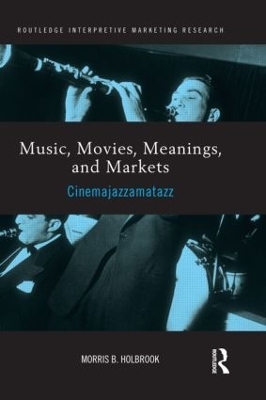
Music, Movies, Meanings, and Markets
Routledge (Verlag)
978-0-415-89313-8 (ISBN)
Consistent with an interest in macromarketing, such ambi-diegetic film music serves as a kind of product placement (suitable for commercialization via the cross-promotion of soundtrack albums, for example) and plays a role in product design. It also provides one type of symbolic consumer behavior that indicates choices made by film characters when playing-singing-listening-or-dancing in ways that reveal their personalities or convey other cinemusical meanings. Morris Holbrook argues that ambi-diegetic film music sheds light on various social issues –such as the age-old tension between art and entertainment as it applies to the contrast between creative integrity and commercialization. Music, Movies, Meanings, and Markets explores the ways in which ambi-diegetic jazz contributes to the development of dramatic meanings in various films, many of which address the art-versus-commerce theme as a central concern.
Morris B. Holbrook is the W. T. Dillard Professor Emeritus of Marketing in the Graduate School of Business at Columbia University. His research has covered a wide variety of topics in marketing, consumer behavior, and related fields – with a special focus on communication in general and on aesthetics, semiotics, hermeneutics, art, and entertainment in particular. Recent books include Consumer Research (1995); Consumer Value (edited, 1999); and Playing the Changes on the Jazz Metaphor (2007).
Part I: Introduction: Ambi-Diegetic Music in Motion Pictures 1.The Role of Ambi-Diegetic Film Music in the Product Design of Hollywood Movies: Macromarketing in La-La-Land Part II: Ambi-Diegetic Jazz and the Development of Character 2. Ambi-Diegetic Film Music As a Product-Design and -Placement Strategy: The Crosby Duets in High Society (1956) 3. The Cinemusical Role of "My Funny Valentine" In The Fabulous Baker Boys (1989) and The Talented Mr. Ripley (1999) Part III: The Plot Thickens: Cinemusical Meanings in the Crime-Plus-Jazz Genre 4. Pete Kelly’s Blues (1955) 5. The Cotton Club (1984) 6. Kansas City (1996) Part IV: Jazz, Films, and Macromarketing Themes: Art versus Commerce in the Young Man-With-A-Horn Genre 7. Young Man with a Horn (1949) 8. Paris Blues (1961) 9. Mo’ Better Blues (1990) Part V: Ambi-Diegetic, Nondiegetic, and Diegetic Cinemusical Meanings in Motion Pictures: Commerce, Art, and Brando Loyalty ... Or ... De Niro, My God, To Thee 10. Commerce And New York, New York (1977): He’s Delightful; He’s Delicious; He’s ... De Niro 11. Art and Heart Beat (1980): Stars Fell on Algolagnia 12. Brando Loyalty and The Score (2001): How Do You Keep The Music Paying? Part VI: God Is In the Details 13. His Eye Is On the Sparrow: Small-But-Significant Cinemusical Moments in Jazz Film Scores by Miles Davis and John Lewis 14. Small-But-Significant Implications of the Man Who Isn’t There In Sweet Smell of Success (1957) Part VII: Jazz Biopics As Tragedy and Comedy: Pivotal Ambi-Diegetic Cinemusical Moments in Tragedepictions and Comedepictions of Jazz Heroes 15. When Bad Things Happen To Great Musicians: The Troubled Role of Ambi-Diegetic Jazz in Three Tragedepictions of Artistic Genius on the Silver Screen 16. A Cinemusicaliterary Analysis of the American Dream As Represented By Biographical Jazz Comedepictions in the Golden Age of Hollywood Biopics: Blow, Horatio, Blow; O, Jakie, O; Go, Tommy, Go; No, Artie, No
| Erscheint lt. Verlag | 15.7.2011 |
|---|---|
| Reihe/Serie | Routledge Interpretive Marketing Research |
| Zusatzinfo | 3 Tables, black and white |
| Verlagsort | London |
| Sprache | englisch |
| Maße | 152 x 229 mm |
| Gewicht | 910 g |
| Themenwelt | Kunst / Musik / Theater ► Film / TV |
| Kunst / Musik / Theater ► Musik ► Jazz / Blues | |
| Kunst / Musik / Theater ► Musik ► Klassik / Oper / Musical | |
| Kunst / Musik / Theater ► Musik ► Musiktheorie / Musiklehre | |
| Kunst / Musik / Theater ► Musik ► Pop / Rock | |
| Sozialwissenschaften ► Kommunikation / Medien ► Medienwissenschaft | |
| Wirtschaft ► Betriebswirtschaft / Management ► Marketing / Vertrieb | |
| Wirtschaft ► Volkswirtschaftslehre | |
| ISBN-10 | 0-415-89313-5 / 0415893135 |
| ISBN-13 | 978-0-415-89313-8 / 9780415893138 |
| Zustand | Neuware |
| Haben Sie eine Frage zum Produkt? |
aus dem Bereich


